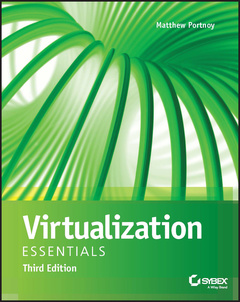Description
Virtualization Essentials (3rd Ed.)
Author: Portnoy Matthew
Language: English
Subject for Virtualization Essentials:
336 p. · 18.3x23.1 cm · Paperback
Description
/li>Contents
/li>Biography
/li>
Learn the fundamental concepts and skills by building your own virtual machine
Virtualization is more important than ever, it's how the Cloud works! As virtualization continues to expand, millions of companies all over the world are leveraging virtualization. IT professionals need a solid understanding of virtualization concepts and software to compete in today's job market.
The updated new edition of Virtualization Essentials teaches you the core concepts and skills necessary to work with virtualization environments. Designed for new and aspiring IT professionals alike, this practical guide offers an applied, real-world approach to help you develop the necessary skill set to work in Cloud computing, the DevOps space, and the rest of the virtual world.
Virtualization Essentials simplifies complex concepts to ensure that you fully understand what virtualization is and how it works within the computing environment. Step by step, you?ll learn how to build your own virtual machine, both by scratch and by migrating from physical to virtual. Each user-friendly chapter contains an overview of the topic, a discussion of key concepts, hands-on tutorials, end-of-chapter exercises, review questions, and more.
- Configure and manage a virtual machine?s CPU, memory, storage, and networking
- Distinguish between Type 1 and Type 2 hypervisors
- Compare the leading hypervisor products in today?s market
- Configure additional devices for a virtual machine
- Make considerations for availability
- Understand how cloud computing leverages virtualization
Virtualization Essentials is an invaluable ?learn-by-doing? resource for new and aspiring IT professionals looking to gain a solid foundation in virtualization. It is also an excellent reference for more experienced IT admins responsible for managing on-premise and remote computers and workstations.
Introduction xv
Chapter 1 Understanding Virtualization 1
Describing Virtualization 1
Microsoft Windows Drives Server Growth 3
Explaining Moore’s Law 7
Understanding the Importance of Virtualization 10
Examining Today’s Trends 12
Virtualization and Cloud Computing 15
Hyperconverged Infrastructure 16
Understanding Virtualization Software Operation 17
Virtualizing Servers 17
Virtualizing Desktops 18
Virtualizing Applications 19
Chapter 2 Understanding Hypervisors 23
Describing a Hypervisor 23
Exploring the History of Hypervisors 24
Understanding Type 1 Hypervisors 25
Understanding Type 2 Hypervisors 27
Understanding the Role of a Hypervisor 28
Holodecks and Traffic Cops 28
Resource Allocation 30
Comparing Today’s Hypervisors 31
VMware ESX 31
Citrix Hypervisor (Xen) 33
Microsoft Hyper- V 35
Other Solutions 36
Chapter 3 Understanding Virtual Machines 39
Describing a Virtual Machine 39
Examining CPUs in a Virtual Machine 42
Examining Memory in a Virtual Machine 43
Examining Network Resources in a Virtual Machine 44
Examining Storage in a Virtual Machine 45
Understanding How a Virtual Machine Works 47
Working with Virtual Machines 49
Understanding Virtual Machine Clones 50
Understanding Templates 51
Understanding Snapshots 52
Understanding OVF 53
Understanding Containers 54
Chapter 4 Creating a Virtual Machine 57
Performing P2V Conversions 57
Investigating the Physical- to- Virtual Process 58
Hot and Cold Cloning 59
Loading Your Environment 60
Loading VMware Workstation Player 61
Exploring VMware Workstation Player 66
Loading VirtualBox 70
Building a New Virtual Machine 75
Thinking About VM Configuration 76
Creating a First VM 77
Chapter 5 Installing Windows on a Virtual Machine 83
Loading Windows into a Virtual Machine 83
Installing Windows 11 84
Installing VMware Tools 97
Understanding Configuration Options 102
Optimizing a New Virtual Machine 107
Chapter 6 Installing Linux on a Virtual Machine 111
Loading Linux into a Virtual Machine 111
Exploring Oracle VM VirtualBox 112
Installing Linux into a Virtual Machine 115
Installing VirtualBox Guest Additions 126
Understanding Configuration Options 129
Optimizing a New Linux Virtual Machine 135
Chapter 7 Managing CPUs for a Virtual Machine 139
Understanding CPU Virtualization 139
Configuring VM CPU Options 143
Tuning Practices for VM CPUs 145
Choosing Multiple vCPUs vs a Single vCPU 145
Hyperthreading 146
Working with Intel and AMD Servers 147
Chapter 8 Managing Memory for a Virtual Machine 151
Understanding Memory Virtualization 151
Configuring VM Memory Options 154
Tuning Practices for VM Memory 156
Calculating Memory Overhead 157
Memory Optimizations 158
Chapter 9 Managing Storage for a Virtual Machine 165
Understanding Storage Virtualization 165
Configuring VM Storage Options 171
Tuning VM Storage 179
Chapter 10 Managing Networking for a Virtual Machine 187
Understanding Network Virtualization 187
Configuring VM Network Options 198
Tuning Practices for Virtual Networks 203
Chapter 11 Copying a Virtual Machine 207
Cloning a Virtual Machine 207
Working with Templates 217
Saving a Virtual Machine State 221
Creating a Snapshot 224
Merging Snapshots 228
Chapter 12 Managing Additional Devices in Virtual Machines 231
Using Virtual Machine Tools 231
Understanding Virtual Devices 234
Configuring a CD/DVD Drive 234
Configuring a Floppy Disk Drive 235
Configuring a Sound Card 239
Configuring USB Devices 240
Configuring Graphic Displays 242
Configuring Other Devices 243
Chapter 13 Understanding Availability 249
Increasing Availability 249
Protecting a Virtual Machine 252
Protecting Multiple Virtual Machines 256
Protecting Data Centers 261
Chapter 14 Understanding Applications in a Virtual Machine 265
Examining Virtual Infrastructure Performance Capabilities 265
Deploying Applications in a Virtual Environment 270
Understanding Virtual Appliances and vApps 279
Open Stack and Containers 281
Cloud and the Future of Virtualization 282
Appendix: Answers to Additional Exercises 285
Glossary 295
Index 301
About the Author
Matthew Portnoy is an information technology professional and Sales Engineering Manager at Splunk. He specializes in data management and virtualization. He has over 30 years’ experience in the IT industry and is a former Staff System Engineer at VMware.




